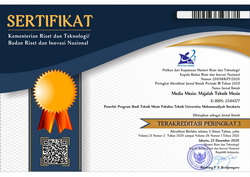INVESTIGATION OF THE EFFECT OF MESH SIZE AND FRACTION VOLUME ON BENDING STRENGTH CHARACTERISTICS OF GEOPOLYMER COMPOSITE
Ridwan Afandi(1), Muhammad Munadi(2*), Fajar Paundra(3), Sri Hastuti(4), Akhmad Nurdin(5)(1) Departement of Foundry Manufacturing Politechnic of Ceper
(2) Departement of Foundry Manufacturing Politechnic of Ceper
(3) Department of Mechanical Engineering, Sumatera Institute of Technology
(4) Universitas Tidar
(5) Department of Engineering Design Manufacturing Technology Manufacturing Politechnic of Ceper
(*) Corresponding Author
Abstract
Composite material is a material consisting of two or more type materials that have different properties, by combining macroscopically, and good interfacial bonds from one material to another. Currently, polymer composite materials are widely applied in the land, sea, and air transportation industries, moreover polymer composites with fire resistance properties have been developed with the addition of geopolymer that has the advantage of producing high performance. This study aims to determine the effect of mesh size and volume fraction of lightweight brick powder on flexural strength. The benefits of this research directly increase the economic value of lightweight brick waste and produce a tough advanced material at a low cost. The composite filling material used lightweight brick waste and sieved using a sieve with a level of 50, 100, 150, and 200 at a volume fraction of 45%, and a volume fraction of 0%, 15%, 30%, 45%, and 60% at a mesh 200. While the composite matrix used the thermoset polymer Ripoxy R-804. Based the result, addition of lightweight brick powder with variations in particle size of the lightweight brick powder and volume fraction showed a decrease in flexural strength resistance compared to those without lightweight brick powder.
Keywords
Full Text:
PDFReferences
A. Nurdin, S. Hastuti, H. P. D, and H. Rino, 2019. “Pengaruh Alkali dan Fraksi Volume terhadap Sifat Mekanik Komposit Serat Akar Wangi – Epoxy,” ROTASI, vol. 21, no. 1, pp. 30–35.
F. Paunda, K. Imad, A. Muhyi, O. Sumardi, and S. Rojikin, 2022. “Kekuatan Tarik Komposit Hybrid Bermatrik,” J. Foundry, vol. 5, no. 1, pp. 12–18,.
L. Diana, A. G. Safitra, and M. N. Ariansyah, 2020. “Analisis Kekuatan Tarik pada Material Komposit dengan Serat Penguat Polimer,” J. Engine Energi, Manufaktur, dan Mater., vol. 4, no. 2, pp. 59–67.
K. Priyanto, 2015. “Kekuatan Bending Dan Ketahanan Bakar Komposit Hybrid Serat Gelas, Serat Karbon, Dan Serbuk Genteng Sokka Dengan Matriks Bisphenol-A.,” Universitas Sebelas Maret.
K. Diharjo, B. Kusharjanta, R. A. P. Tarigan, and A. R. Andhika, 2013. “Pengaruh Kandungan Dan Ukuran Serbuk Genteng Sokka Terhadap Ketahanan Bakar Komposit Geopolimer,” J. Rekayasa Mesin, vol. 4, no. 1, pp. 27–34.
Sutrisno, S. Y. Hari, and Mustafa, “Pengaruh Serbuk Geomaterial Pada Komposit,” in Seminar Nasional Sains dan Teknologi Terapan IV 2016, 2016, pp. 117–122.
K. Diharjo, A. Purwanto, J. A. Nasiri, and B. H. Jihad, “Sifat Tahan Api Dan Kekuatan Bending Komposit Geopolimer,” in Prosiding InSINas 2012, 2012, no. February 2020, pp. 67–72.
K. Diharjo and F. Firdaus, 2007. “Fire Resistance Of Fly Ash - Polyester,” J. Tek. Gelagar, vol. 18, no. February, pp. 86–94.
K. Diharjo, Y. Prasetya, M. Masykuri, and N. S. Suharty, 2020. “Fly ash / ripoxy composite : Inflammability on horizontal and surface burning Fly Ash / Ripoxy,” vol. 030009, no. September.
K. Priyanto, A. H. Purwono, and D. A. Cristanto, 2019. “Ketangguhan Impak Dan Kekuatan Tarik Komposit Fiberglass / Clay Filler Bermatriks Unsaturated Polyester Bqtn-Ex 157,” J. Tek. ATW, vol. 6, no. September, pp. 45–53.
K. Diharjo, V. B. Armunanto, S. A. Kristiawan, K. Diharjo, V. B. Armunanto, and S. A. Kristiawan, 2016. “Tensile and Burning Properties of Clay / Phenolic / GF Composite and Its Application,” vol. 040024.
R. A. P. Tarigan, “Pengaruh Fraksi Berat Dan Ukuran Serbuk Genteng Sokka Terhadap Ketahanan Bakar Komposit Geopolimer,” Universitas Sebelas Maret, 2013.
A. H. Purwono, K. Priyanto, K. Saka, and A. Pangestu, 2019. “Studi Konduktivitas Termal Komposit Geopolimer Dengan Matriks Hdpe Daur Ulang,” J. Tek. ATW, vol. 6, no. September, pp. 40–44.
A. Nurdin and D. A. Himawanto, 2019. “Studi numerik kekuatan material transmisi roda gigi pico hydro,” JTMI, vol. 14, no. 1, pp. 24–29.
C. Harjani, P. Noviandri, U. Kristen, and D. Wacana, 2019.“Desain partisi penyerap noise berbahan komposit
kain perca,” Lintas Ruang, no. August.
A. Pujianto, R. Faizah, A. Widiyanto, T. A. Putra, H. Prayuda, and F. Firdausa, 2021.“Pemanfaatan Limbah Bata Ringan Sebagai Bahan Penyusun Pengganti Pada Beton,” J. Bangunan, vol. 26, no. 2, pp. 1–8.
U. Jain, M. Jain, and S. Mandaokar, 2018.“Comparative Study of AAC Blocks and Clay Brick and Costing,” Int. J. Res. Eng. Sci. Manag., vol. 1, no. 9, pp. 539–543.
C. Ansor and IGurharyanto, 2016.“Pemanfaatan Felspar Desa Petir-Kecamatan Bawang Dan Desa Wanadri, Kecamatan Purwanegara, Kabupaten Banjarnegara Untuk Pembuatan Bata Ringan,” Buletin Sumber Daya Geologi Volume, vol. 11, pp. 117–131.
B. D. Prasetyo, K. Diharjo, D. Ariawan, N. S. Suharty, and M. Masykuri, “Flexural and inflammability properties of FA / CF / Phenolic hybrid composite Flexural and Inflammability Properties of FA / CF / Phenolic Hybrid Composite,” in 1st International Seminar on Advances in Metallurgy and Materials (i-SENAMM 2019), 2020, vol. 030006, no. September.
K. Diharjo, Jamasri, and F. Firdaus, “Effect Of Particulate Size Of Fly Ash And Fly-Ash Weight Fraction To Flexural Properties Of Fly Ash –Polyester Composite,” in International Conference On Chemical Sciences (ICCS-2007), 2007, pp. 24–26.
Y. Hakim and E. Kusumastuti, 2017. “Indonesian Journal of Chemical Science Sintesis dan Karakterisasi Geopolimer dengan Penambahan Serat Eceng Gondok dan Serbuk Aluminium,” Indones. J. Chem. Sci., vol. 6, no. 3, pp. 3–10.
Siswanto and K. Diharjo, 2011.“Pengaruh Fraksi Volume Dan Ukuran Partikel Komposit Polyester Resin Berpenguat Partikel Genting Terhadap Kekuatan Tarik Dan Kekuatan Bending,” POLITEKNOSAINS VOL., vol. X, no. 2, pp. 91–99.
Article Metrics
Abstract view(s): 686 time(s)PDF: 569 time(s)
Refbacks
- There are currently no refbacks.








